
PHOTOS FROM THE FARM: 7.24.20
07/24/20 — Ada Broussard
This week at the farm Scott captured images of the okra, harvesting eggplant, basil and other herbs in the herb patch, lemongrass, some new plantings just coming up, and some very colorful peppers. Amazing how the farm just keeps going year round!
![]() Morning skies over fields of okra. Photo by Scott David Gordon
Morning skies over fields of okra. Photo by Scott David Gordon
![]() Okra detail from above. Photo by Scott David Gordon
Okra detail from above. Photo by Scott David Gordon
![]() What an eggplant bounty! Photo by Scott David Gordon
What an eggplant bounty! Photo by Scott David Gordon
![]() The rig that allows the harvest of five rows of plants at one pass. Photo by Scott David Gordon
The rig that allows the harvest of five rows of plants at one pass. Photo by Scott David Gordon
![]() Mounds of Black Beauty Eggplant. Photo by Scott David Gordon
Mounds of Black Beauty Eggplant. Photo by Scott David Gordon
![]() Consolidating the bins. Photo by Scott David Gordon
Consolidating the bins. Photo by Scott David Gordon
![]() Harvesting Basil. Photo by Scott David Gordon
Harvesting Basil. Photo by Scott David Gordon
![]() Basil bunch. Photo by Scott David Gordon
Basil bunch. Photo by Scott David Gordon
![]() The gorgeous hues of Thai basil. Photo by Scott David Gordon
The gorgeous hues of Thai basil. Photo by Scott David Gordon
![]() Bringing in the herbs. Photo by Scott David Gordon
Bringing in the herbs. Photo by Scott David Gordon
![]() Lemongrass harvest. Photo by Scott David Gordon
Lemongrass harvest. Photo by Scott David Gordon
![]() Lemongrass. Photo by Scott David Gordon
Lemongrass. Photo by Scott David Gordon
![]() New plantings, even as it gets hot! Photo by Scott David Gordon
New plantings, even as it gets hot! Photo by Scott David Gordon
![]() Purple bell peppers. Photo by Scott David Gordon
Purple bell peppers. Photo by Scott David Gordon
![]() Bin of purple bells. Photo by Scott David Gordon
Bin of purple bells. Photo by Scott David Gordon
![]() Hot cherry bomb peppers, with heat comparable to jalapenos. Photo by Scott David Gordon
Hot cherry bomb peppers, with heat comparable to jalapenos. Photo by Scott David Gordon
 Morning skies over fields of okra. Photo by Scott David Gordon
Morning skies over fields of okra. Photo by Scott David Gordon
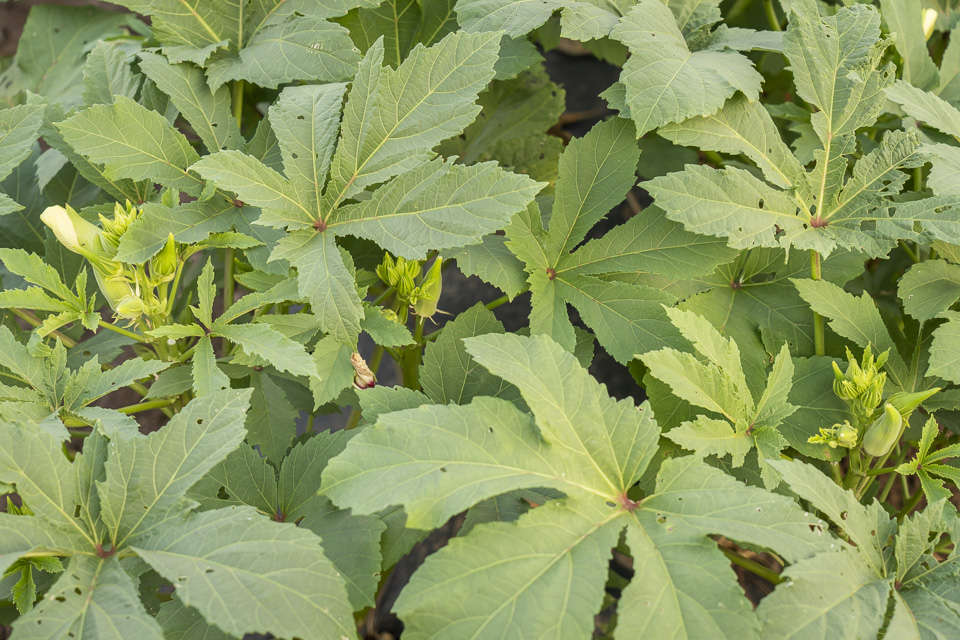 Okra detail from above. Photo by Scott David Gordon
Okra detail from above. Photo by Scott David Gordon
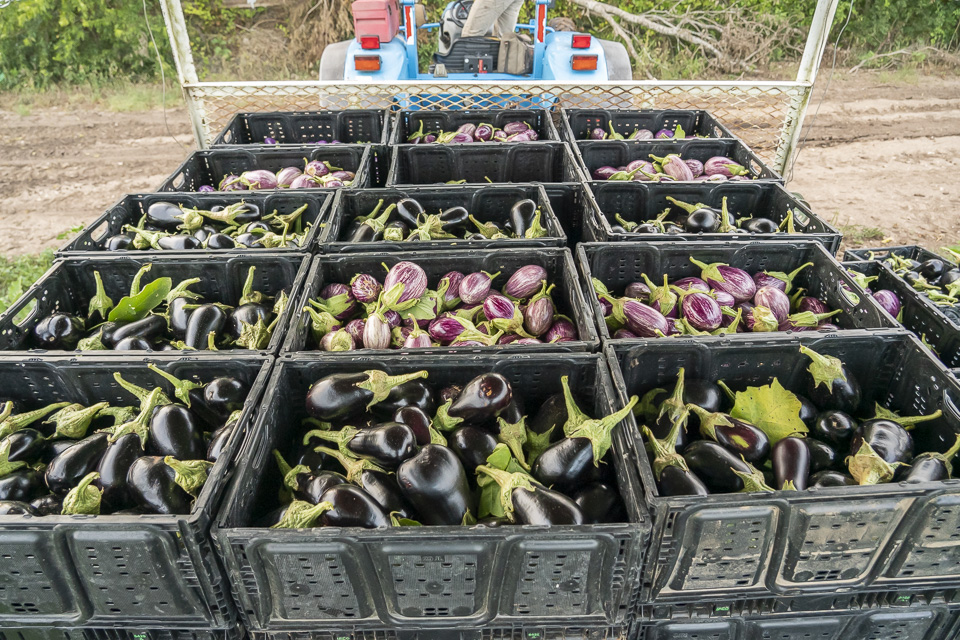 What an eggplant bounty! Photo by Scott David Gordon
What an eggplant bounty! Photo by Scott David Gordon
 The rig that allows the harvest of five rows of plants at one pass. Photo by Scott David Gordon
The rig that allows the harvest of five rows of plants at one pass. Photo by Scott David Gordon
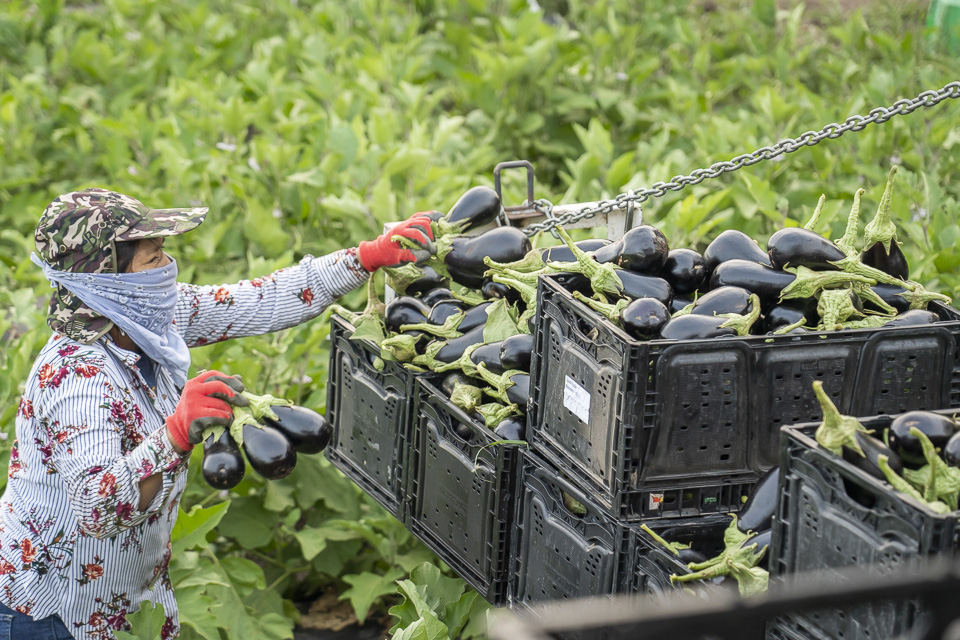 Mounds of Black Beauty Eggplant. Photo by Scott David Gordon
Mounds of Black Beauty Eggplant. Photo by Scott David Gordon
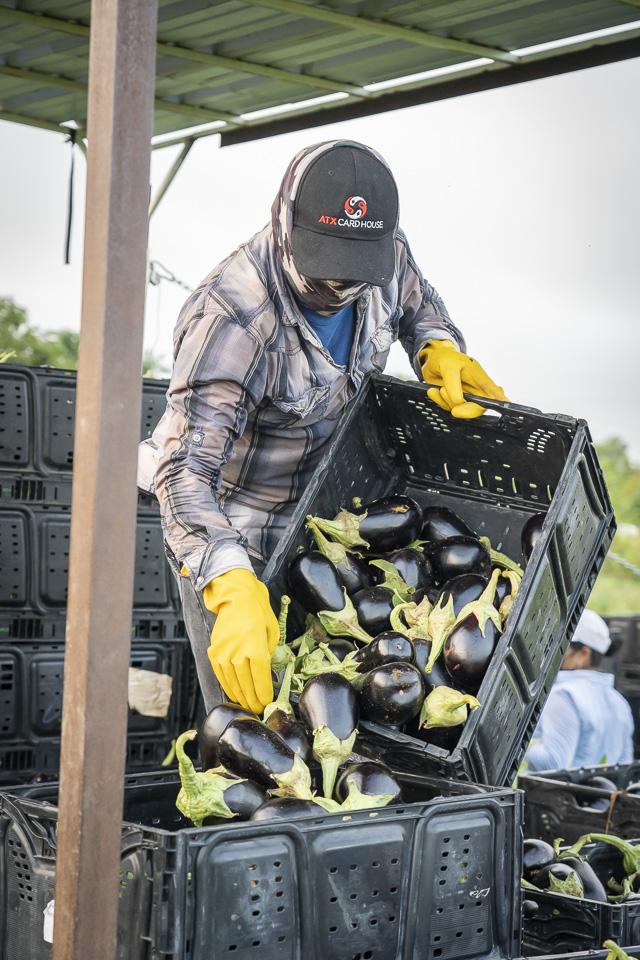 Consolidating the bins. Photo by Scott David Gordon
Consolidating the bins. Photo by Scott David Gordon
 Harvesting Basil. Photo by Scott David Gordon
Harvesting Basil. Photo by Scott David Gordon
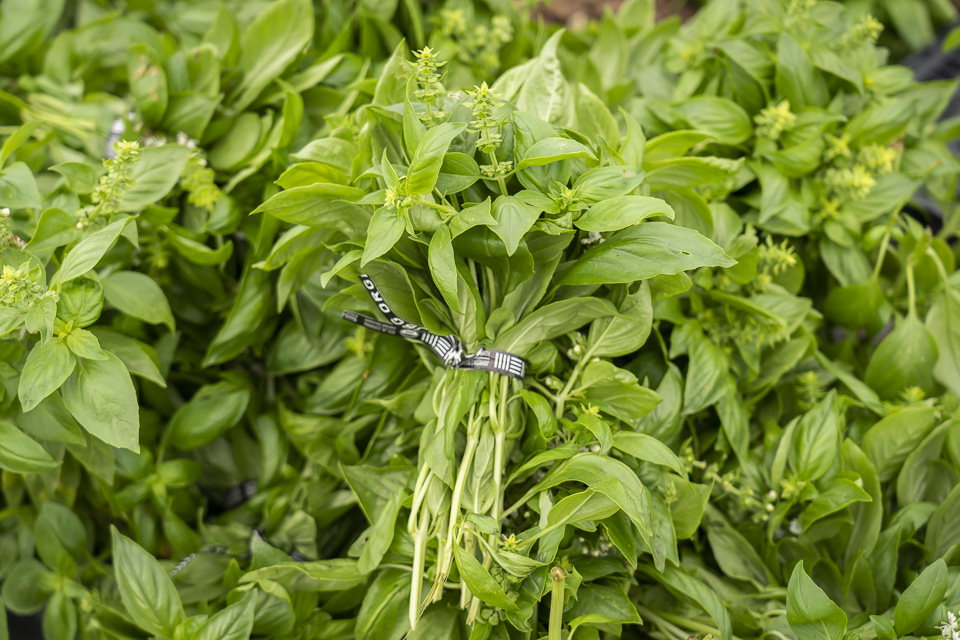 Basil bunch. Photo by Scott David Gordon
Basil bunch. Photo by Scott David Gordon
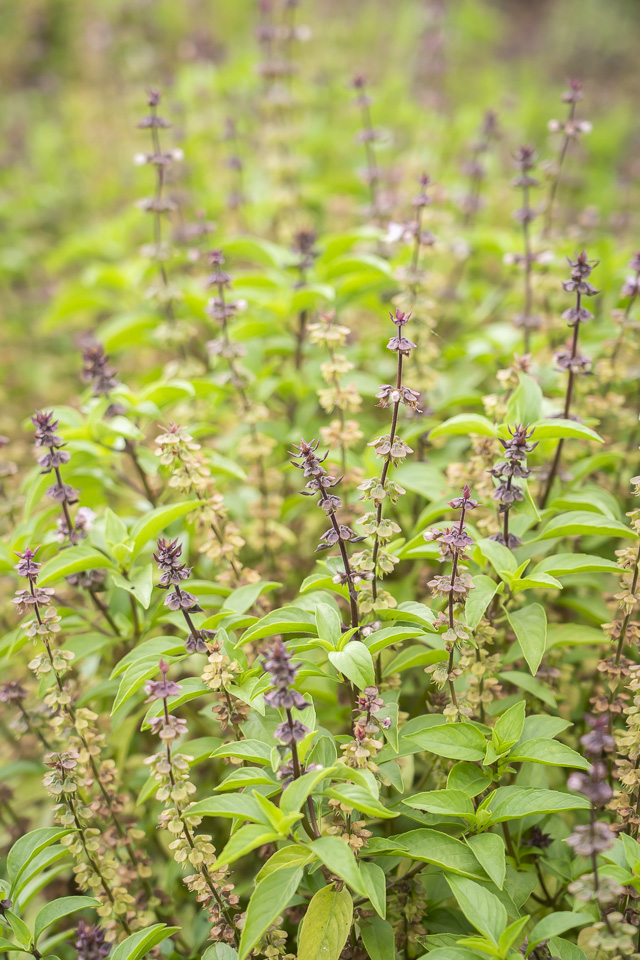 The gorgeous hues of Thai basil. Photo by Scott David Gordon
The gorgeous hues of Thai basil. Photo by Scott David Gordon
 Bringing in the herbs. Photo by Scott David Gordon
Bringing in the herbs. Photo by Scott David Gordon
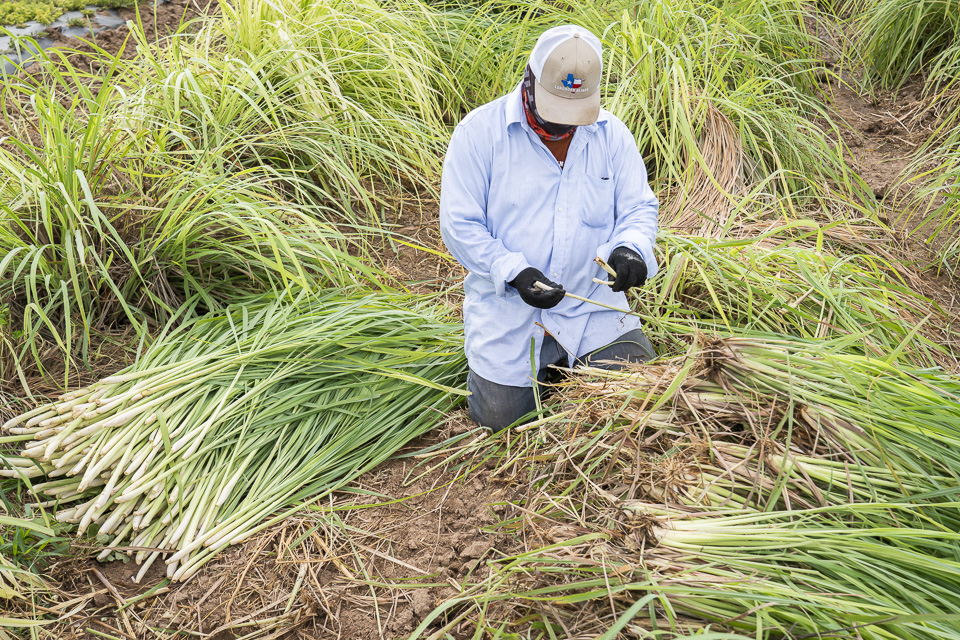 Lemongrass harvest. Photo by Scott David Gordon
Lemongrass harvest. Photo by Scott David Gordon
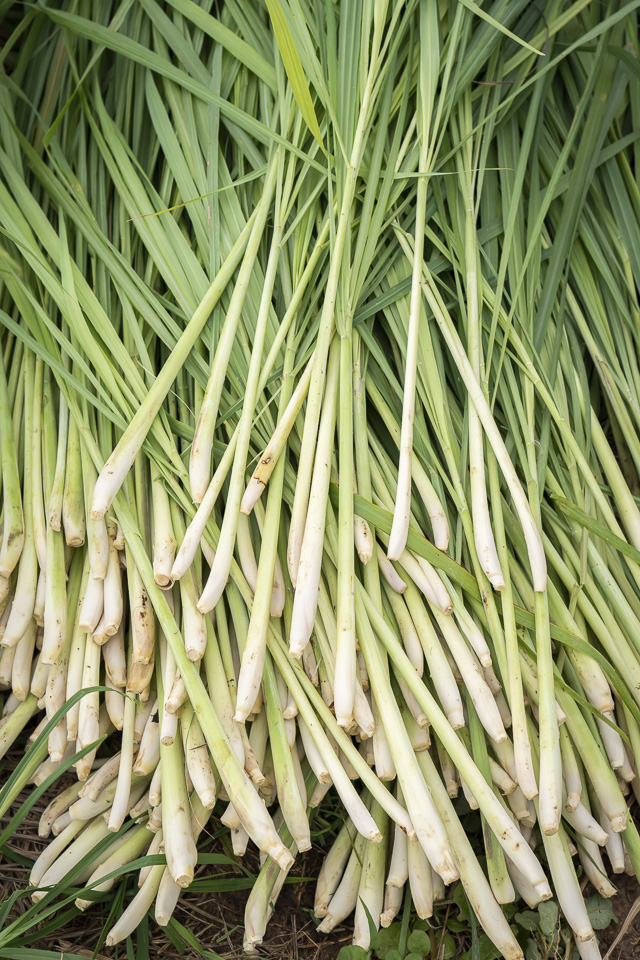 Lemongrass. Photo by Scott David Gordon
Lemongrass. Photo by Scott David Gordon
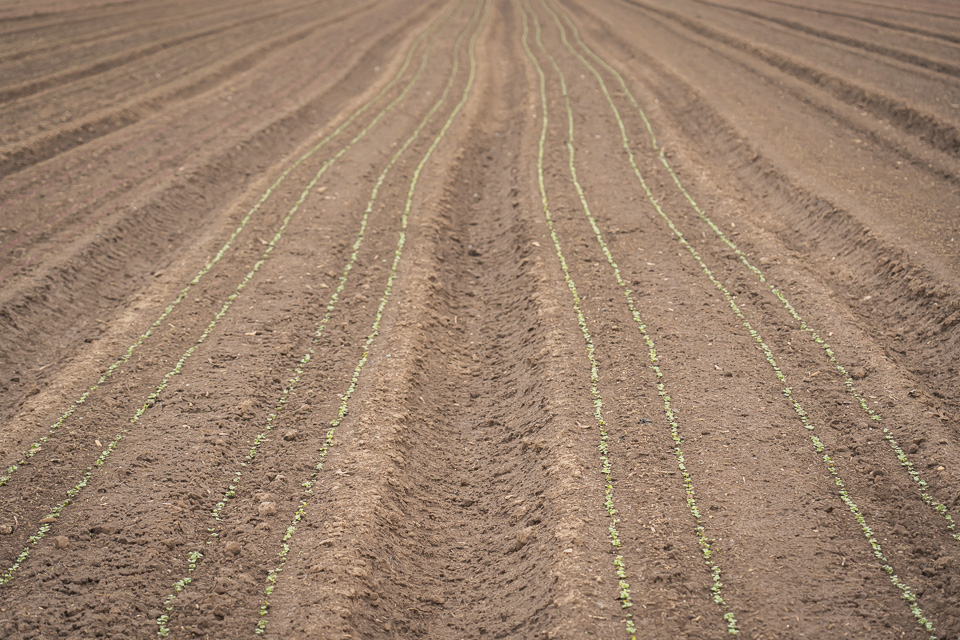 New plantings, even as it gets hot! Photo by Scott David Gordon
New plantings, even as it gets hot! Photo by Scott David Gordon
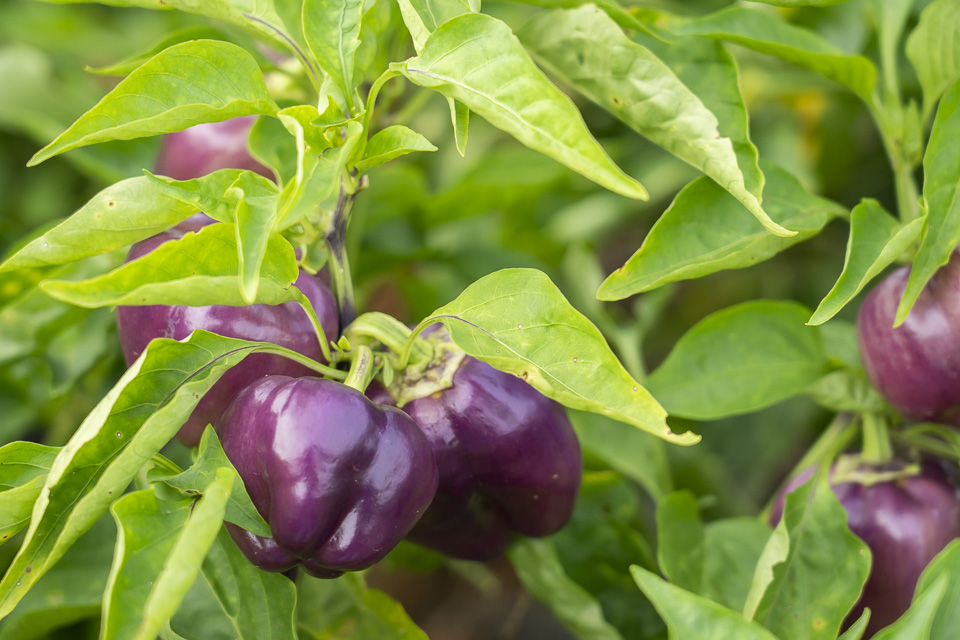 Purple bell peppers. Photo by Scott David Gordon
Purple bell peppers. Photo by Scott David Gordon
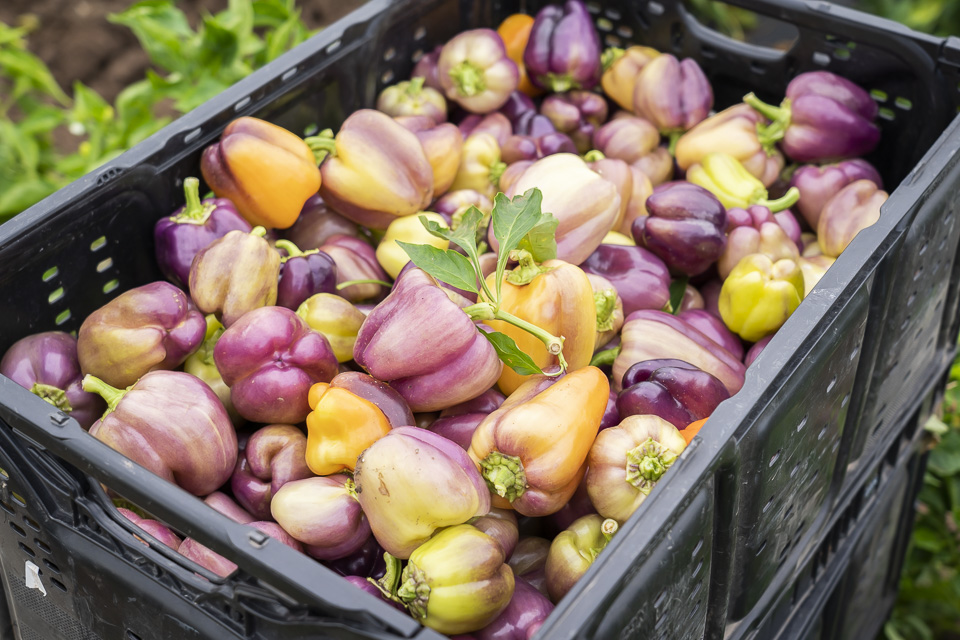 Bin of purple bells. Photo by Scott David Gordon
Bin of purple bells. Photo by Scott David Gordon
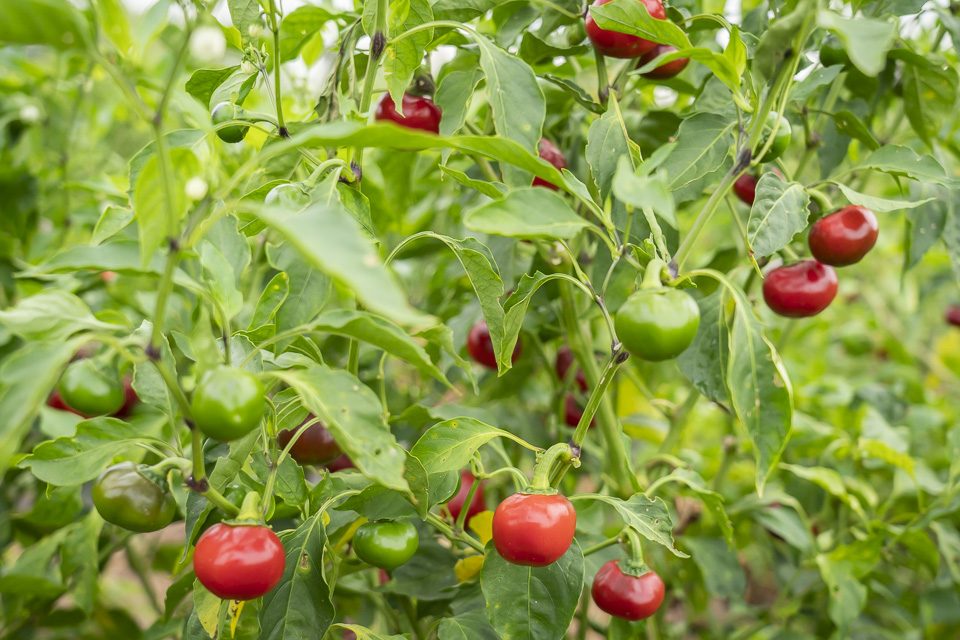 Hot cherry bomb peppers, with heat comparable to jalapenos. Photo by Scott David Gordon
Hot cherry bomb peppers, with heat comparable to jalapenos. Photo by Scott David GordonLIMA BEANS WITH TANGY TOMATOES, OLIVE OIL & FETA CHEESE
07/23/20 — Ada Broussard
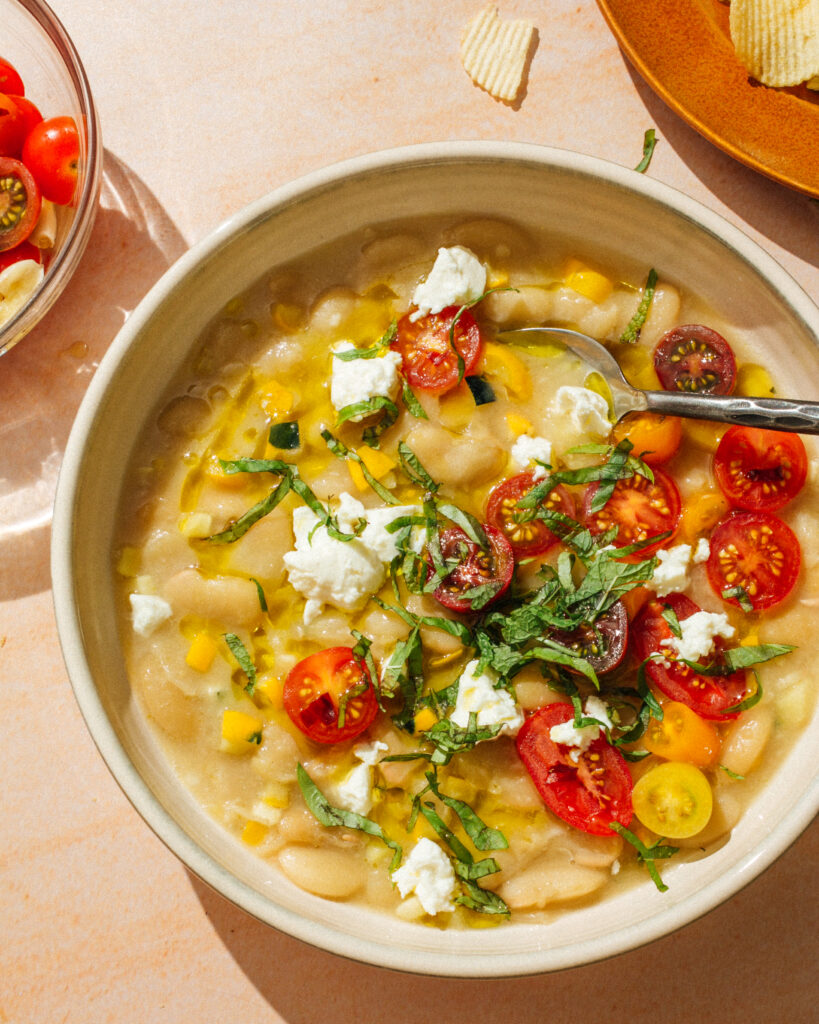 Recipe and photos by Mackenzie Smith.
Recipe and photos by Mackenzie Smith.
This week I made lima beans, and stirred in diced Summer squash just as the beans finished cooking, then topped each bowl with tangy tomatoes that had been hanging out in a bath of red wine vinegar, smashed garlic and dried chiles. Finished with a drizzle of olive oil, fresh herbs, feta cheese and a handful of crushed potato chips— these beans were a hit for the whole family.
- 1 pound dried lima beans
- 7 cups water or chicken stock or vegetable stock (aka any kind of flavorful liquid - adjust
- seasoning to taste if using water)
- 3 cloves garlic, smashed and peeled
- 1 sprig rosemary
- 2 teaspoons kosher salt (or 1 teaspoon table salt)
- 2 tablespoons butter
- 2 medium-sized yellow squash or zucchini, or a small pattypan — diced
- 4-5 tablespoons red wine vinegar
- 4 cloves garlic, smashed
- 1-2 teaspoons salt
- chili flakes to taste
- 1 cup cherry tomatoes, sliced in half — or a large tomato, diced
- fresh mint and basil
- extra virgin olive oil
- potato chips
Once ingredients listed above are in the inner pot, cover it: twist to lock the lid, and turn the valve to sealing. Use Manual mode and set to 25 minutes.
While beans are cooking, put a few cloves of smashed garlic and a teaspoon of salt into 4-5 tablespoons of red wine vinegar and chile flakes. Dice squash into small cubes. Slice or chop tomatoes and add to vinegar. (Remove garlic before serving).
When the timer on the Instant Pot beeps, allow the pressure to release naturally for 20 minutes. Then, turn the valve to venting.
If beans are not soft enough, put the lid back on and make sure the release valve is set to sealing. Use Manual mode to cook at high pressure for another 5. The pot will quickly come back up to pressure because the contents are already hot.
When beans are soft enough, remove from heat and stir in chopped squash. Salt to taste.
Ladle beans and squash into bowls, drizzle with olive oil, sprinkle with feta, and scoop some of the tangy tomatoes onto the beans, along with fresh chopped mint and basil. Topping with crushed potato chips optional but highly recommended :)
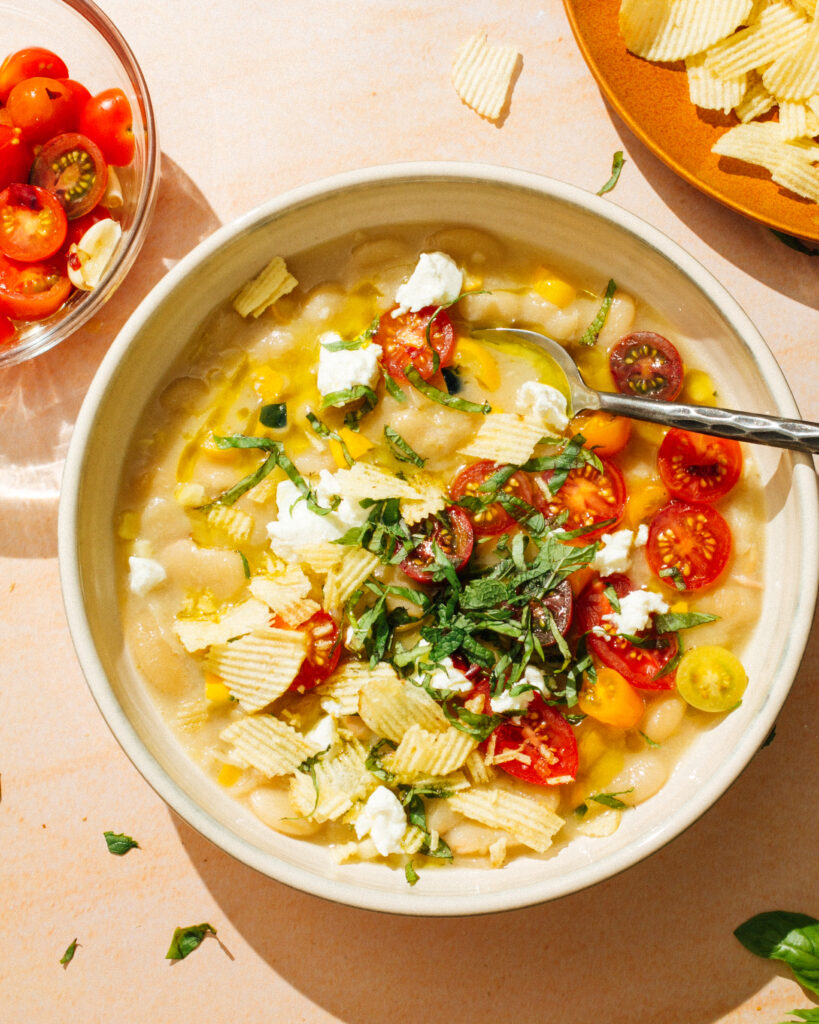 Topping with potato chips is optional, but highly recommended. Photo by Mackenzie Smith.
Topping with potato chips is optional, but highly recommended. Photo by Mackenzie Smith.CSA BOX CONTENTS WEEK OF JULY 20TH
07/20/20 — Scott
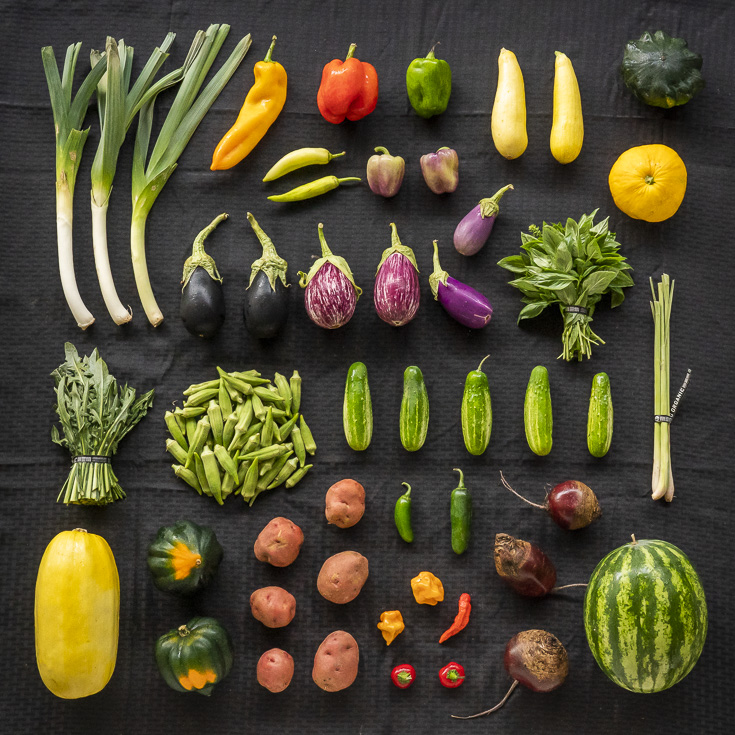 CSA Box Contents Week of July 20th
CSA Box Contents Week of July 20th
Large Box
Beets
Eggplant
Farmers Choice
Greens, Dandelion
Greens, Sweet Potato
Herb, Basil
Melon, Farmers Choice
Okra
Pepper, Sweet
Potato
Radish
Winter Squash
Beets
Eggplant
Farmers Choice
Greens, Dandelion
Greens, Sweet Potato
Herb, Basil
Melon, Farmers Choice
Okra
Pepper, Sweet
Potato
Radish
Winter Squash
Medium Box
Beets
Farmers Choice
Herb, Basil
Leek
Melon, Farmers Choice
Okra
Pepper, Sweet
Potato
Squash, Farmer's Choice
Winter Squash
Beets
Farmers Choice
Herb, Basil
Leek
Melon, Farmers Choice
Okra
Pepper, Sweet
Potato
Squash, Farmer's Choice
Winter Squash
Small Box
Eggplant
Greens, Sweet Potato
Herb, Basil
Leek
Pepper, Sweet
Potato
Squash, Patty Pan
Eggplant
Greens, Sweet Potato
Herb, Basil
Leek
Pepper, Sweet
Potato
Squash, Patty Pan
Individual Box
Beets
Eggplant
Okra
Pepper, Sweet
Winter Squash
Beets
Eggplant
Okra
Pepper, Sweet
Winter Squash
OKRA RECIPES FROM AROUND THE WORLD
07/17/20 — Ada Broussard
Okra plants are related to hibiscus and cotton plants with tropical looking flowers that scream of an equatorial evolution. The earliest known evidence of okra cultivation comes from Ethiopia. Egyptian cultivation of the crop was common by the 12th century B.C., and okra became a prevalent crop in North Africa and the Middle East where the plant could stand up to the hot temperatures. Okra seeds traveled to India along trade routes and to the Caribbeans and Americas via the slave trade, and today, the young seed pods are harvested and chopped up all around the world. There are even Greek and Turkish dishes that celebrate the pods (both regions that used to be under Ottoman control). Caffeine-free coffee alternatives are made with the roasted seeds, and scientists are studying okra slime as a means to make biodegradable food packaging.
![]() Okra in hand. Photo by Scott David Gordon.
Okra in hand. Photo by Scott David Gordon.
Okra’s “mucilage”, or the slime factor, is an inherent quality of the vegetables. Roasting the pods whole in a very hot oven can minimize the slime, but really, okra is slime. In fact, this slimy quality is often wielded as an advantage, used to thicken soups and stews. Okra is as polarizing as cilantro and is a take-it or leave-it vegetable for many. If you’re on team “take-it” but are growing weary of your usual okra dishes, we’ve got a few recipes from around the world to spice up your okra experience. Disclaimer: what you won’t see below is a fried okra recipe because we’re working off the assumption that you’re already doing this. If not, better hurry. This peculiar and unique pod won’t be around forever!
![]() Swimming (JBG) okra. Photo by JBG recipe developer and food photographer, Mackenzie Smith.
Swimming (JBG) okra. Photo by JBG recipe developer and food photographer, Mackenzie Smith.
Gumbo: The word gumbo is actually a derivative of a West African word for okra, and in many Créole gumbo recipes, okra is a main ingredient used to thicken the stew. If you ask us, it’s a big hot for gumbo at the moment. Do your future self a favor, and chop, blanch, and freeze your next clamshell of JBG okra. It will be waiting for you just in time for the first cold snap of the fall, sitting next to your popsicles and cheering you along through the hot, hot summer.
![]() Okra leaves and flowers, reaching for the sky. Photo by Scott David Gordon.
Okra leaves and flowers, reaching for the sky. Photo by Scott David Gordon.
Bindi Masala: This is an Indian dish of cooked okra (or "ladyfingers") with toasted spices, and sometimes other vegetables like onions and tomatoes. If you like Indian cuisine and haven’t dabbled into the world of Youtube tutorials on popular Indian dishes, buckle up. There are so many wonderful home cooks sharing their recipes on Youtube. Here is just one of many videos we found for bindi masala. We checked in with our operations manger, Krishna, to see if he had any tips for making bindi masala at home. He said that you can eat bindi masala as a side dish, or can even roll the okra stir fry in a tortilla (which should probably be heated and brushed with ghee ) .
![]() Green okra, ready to roll. Photo by Scott David Gordon.
Green okra, ready to roll. Photo by Scott David Gordon.
Bamya: Tomatoes and okra both come into season during the same hot moments every summer and so it should be no surprise that many okra recipes from around the world pair acidic tomatoes with silky (slimy?) okra. The two just go together. Bamya, the word for okra in Arabic, is also the name of an Egyptian okra and tomato stew , often containing lamb or beef, and sometimes served with spaghetti noodles! Unlike the 2-5 (sometimes 6!) inch okra that you’ll often find in the United States, okra in other parts of the world are harvested when they’re so tiny - shy of even an inch! Baby Bamya!
![]() Bulk okra at market.Must be summer! Photo by Scott David Gordon.
Bulk okra at market.Must be summer! Photo by Scott David Gordon.
Maafe: Maafe is the word for a West African peanut (or groundnut!) stew, of which there are many, many variations, some involving proteins like beef or chicken, and some involving vegetables like tomatoes, corn, and the pod of the hour: okra. Whereas so many okra recipes lean on the acid side (thank you, tomatoes), this stew envelopes okra in a creamy and rich sauce that will surely be an okra expedition for many. This recipe from the blog Chocolate for Basil seems like a great starting point to these West African flavors.
![]() Okra pods have tiny hairs that can irritate the skin after a prolonged period of harvesting. Thankfully, there is an easy solution: gloves. Photo by Scott David Gordon.
Okra pods have tiny hairs that can irritate the skin after a prolonged period of harvesting. Thankfully, there is an easy solution: gloves. Photo by Scott David Gordon.
Okra Ohitashi: Cold, marinated okra might be your next favorite way to enjoy this vegetable. Ohitashi refers to a Japanese dish that is, most simply, a blanched vegetable soaked in dashi, or a Japanese umami-rich broth made a number of ways, depending on the type. Making a simple dashi at home is easy, and blanching okra is literally as easy as boiling water. We love this recipe for okra ohitashi and the gateway it provides to ohitashi of all types. CSA Members, take note! Here is a gateway cooking technique with endless seasonal variations!
![]() If consistently picked, okra plants will continue to grow tall, all season long, with the fresh pods emerging at the top of the strong stalk. Photo by Scott David Gordon.
If consistently picked, okra plants will continue to grow tall, all season long, with the fresh pods emerging at the top of the strong stalk. Photo by Scott David Gordon.
Coconut Okra Rice: We thought we were done suggesting okra recipes until we stumbled upon this recipe from The Caribbean Pot which makes a rice pilaf, of sorts, with okra and coconut milk. This recipe calls for a medley of peppers, both hot and sweet, making it a perfect one-pot summer dish to show off some seasonal veg.
Go forth, and okra!
 Okra in hand. Photo by Scott David Gordon.
Okra in hand. Photo by Scott David Gordon.
Okra’s “mucilage”, or the slime factor, is an inherent quality of the vegetables. Roasting the pods whole in a very hot oven can minimize the slime, but really, okra is slime. In fact, this slimy quality is often wielded as an advantage, used to thicken soups and stews. Okra is as polarizing as cilantro and is a take-it or leave-it vegetable for many. If you’re on team “take-it” but are growing weary of your usual okra dishes, we’ve got a few recipes from around the world to spice up your okra experience. Disclaimer: what you won’t see below is a fried okra recipe because we’re working off the assumption that you’re already doing this. If not, better hurry. This peculiar and unique pod won’t be around forever!
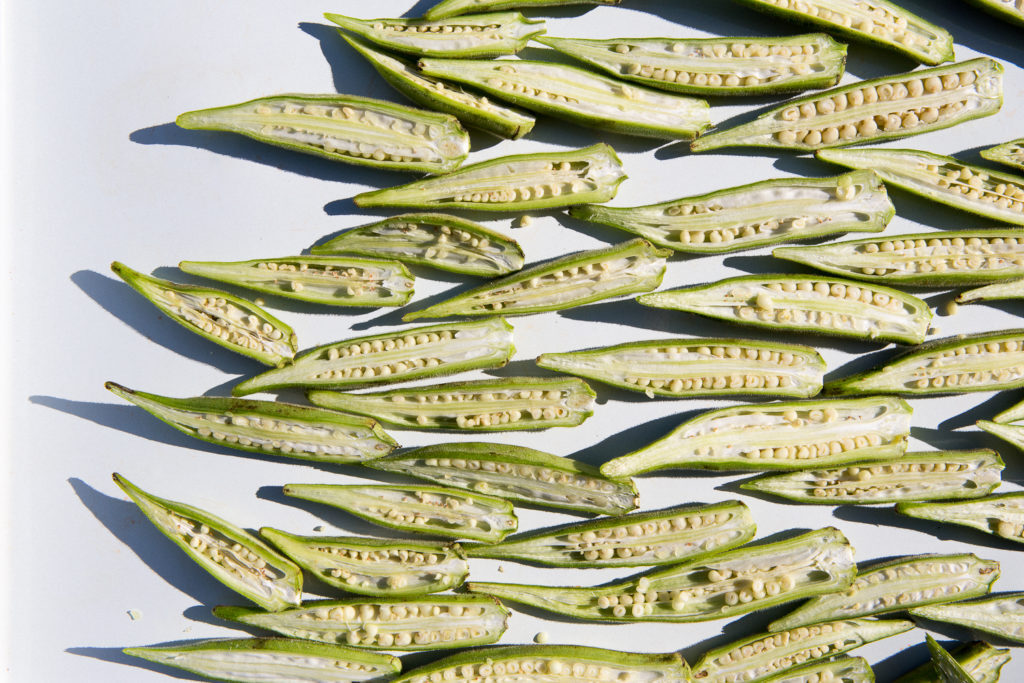 Swimming (JBG) okra. Photo by JBG recipe developer and food photographer, Mackenzie Smith.
Swimming (JBG) okra. Photo by JBG recipe developer and food photographer, Mackenzie Smith.
Gumbo: The word gumbo is actually a derivative of a West African word for okra, and in many Créole gumbo recipes, okra is a main ingredient used to thicken the stew. If you ask us, it’s a big hot for gumbo at the moment. Do your future self a favor, and chop, blanch, and freeze your next clamshell of JBG okra. It will be waiting for you just in time for the first cold snap of the fall, sitting next to your popsicles and cheering you along through the hot, hot summer.
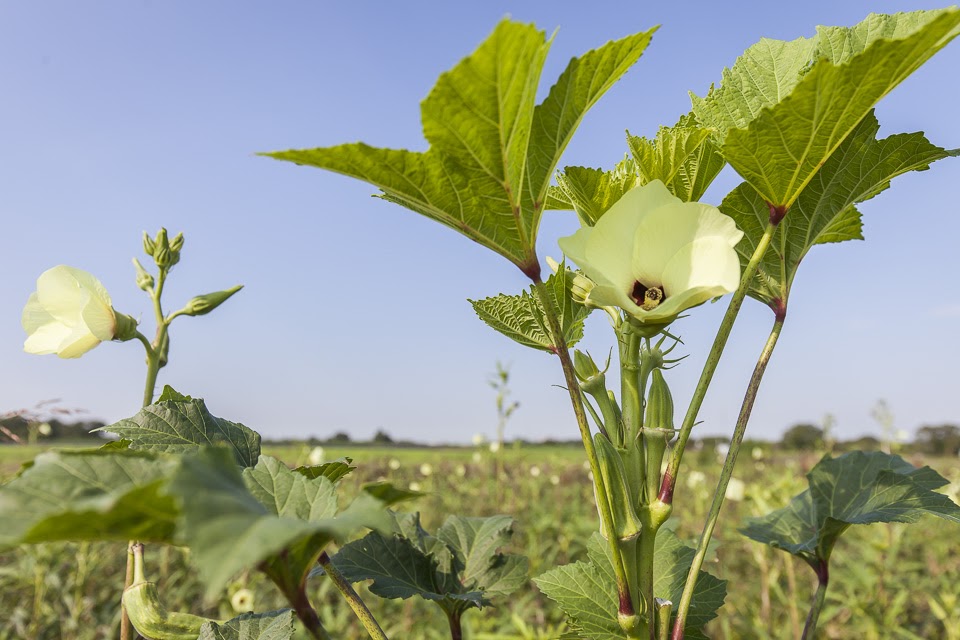 Okra leaves and flowers, reaching for the sky. Photo by Scott David Gordon.
Okra leaves and flowers, reaching for the sky. Photo by Scott David Gordon.
Bindi Masala: This is an Indian dish of cooked okra (or "ladyfingers") with toasted spices, and sometimes other vegetables like onions and tomatoes. If you like Indian cuisine and haven’t dabbled into the world of Youtube tutorials on popular Indian dishes, buckle up. There are so many wonderful home cooks sharing their recipes on Youtube. Here is just one of many videos we found for bindi masala. We checked in with our operations manger, Krishna, to see if he had any tips for making bindi masala at home. He said that you can eat bindi masala as a side dish, or can even roll the okra stir fry in a tortilla (which should probably be heated and brushed with ghee ) .
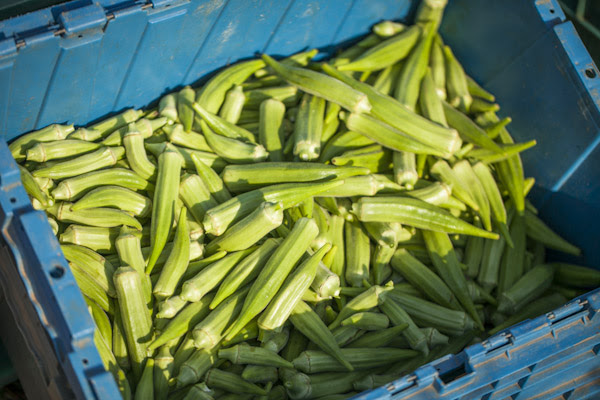 Green okra, ready to roll. Photo by Scott David Gordon.
Green okra, ready to roll. Photo by Scott David Gordon.
Bamya: Tomatoes and okra both come into season during the same hot moments every summer and so it should be no surprise that many okra recipes from around the world pair acidic tomatoes with silky (slimy?) okra. The two just go together. Bamya, the word for okra in Arabic, is also the name of an Egyptian okra and tomato stew , often containing lamb or beef, and sometimes served with spaghetti noodles! Unlike the 2-5 (sometimes 6!) inch okra that you’ll often find in the United States, okra in other parts of the world are harvested when they’re so tiny - shy of even an inch! Baby Bamya!
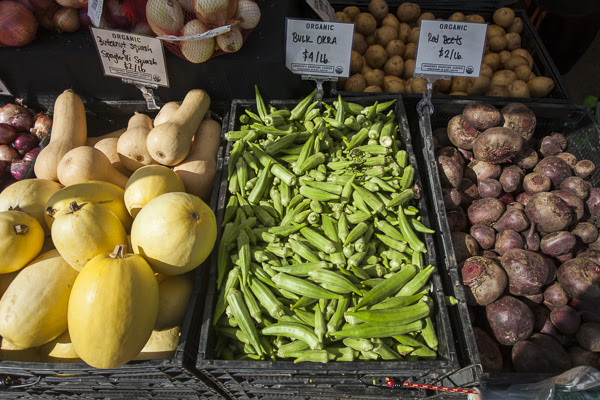 Bulk okra at market.Must be summer! Photo by Scott David Gordon.
Bulk okra at market.Must be summer! Photo by Scott David Gordon.
Maafe: Maafe is the word for a West African peanut (or groundnut!) stew, of which there are many, many variations, some involving proteins like beef or chicken, and some involving vegetables like tomatoes, corn, and the pod of the hour: okra. Whereas so many okra recipes lean on the acid side (thank you, tomatoes), this stew envelopes okra in a creamy and rich sauce that will surely be an okra expedition for many. This recipe from the blog Chocolate for Basil seems like a great starting point to these West African flavors.
 Okra pods have tiny hairs that can irritate the skin after a prolonged period of harvesting. Thankfully, there is an easy solution: gloves. Photo by Scott David Gordon.
Okra pods have tiny hairs that can irritate the skin after a prolonged period of harvesting. Thankfully, there is an easy solution: gloves. Photo by Scott David Gordon.
Okra Ohitashi: Cold, marinated okra might be your next favorite way to enjoy this vegetable. Ohitashi refers to a Japanese dish that is, most simply, a blanched vegetable soaked in dashi, or a Japanese umami-rich broth made a number of ways, depending on the type. Making a simple dashi at home is easy, and blanching okra is literally as easy as boiling water. We love this recipe for okra ohitashi and the gateway it provides to ohitashi of all types. CSA Members, take note! Here is a gateway cooking technique with endless seasonal variations!
 If consistently picked, okra plants will continue to grow tall, all season long, with the fresh pods emerging at the top of the strong stalk. Photo by Scott David Gordon.
If consistently picked, okra plants will continue to grow tall, all season long, with the fresh pods emerging at the top of the strong stalk. Photo by Scott David Gordon.
Coconut Okra Rice: We thought we were done suggesting okra recipes until we stumbled upon this recipe from The Caribbean Pot which makes a rice pilaf, of sorts, with okra and coconut milk. This recipe calls for a medley of peppers, both hot and sweet, making it a perfect one-pot summer dish to show off some seasonal veg.
Go forth, and okra!
CSA BOX CONTENTS WEEK OF JULY 13TH
07/14/20 — Scott
 CSA Box Contents Week of July 13th
CSA Box Contents Week of July 13th
Large Box
Beets
Cucumber
Eggplant
Greens, Dandelion
Herb, Farmers Choice
Leek
Melon, Farmers Choice
Pepper, Hot Medley
Pepper, Sweet Medley
Potato
Squash. Summer Medley
Winter Squash
Beets
Cucumber
Eggplant
Greens, Dandelion
Herb, Farmers Choice
Leek
Melon, Farmers Choice
Pepper, Hot Medley
Pepper, Sweet Medley
Potato
Squash. Summer Medley
Winter Squash
Medium Box
Beets
Cucumber
Eggplant
Herb, Farmers Choice
Herb, Lemongrass
Melon, Farmers Choice
Okra
Pepper, Sweet Medley
Potato
Winter Squash
Beets
Cucumber
Eggplant
Herb, Farmers Choice
Herb, Lemongrass
Melon, Farmers Choice
Okra
Pepper, Sweet Medley
Potato
Winter Squash
Small Box
Beets
Cucumber
Herb, Farmers Choice
Melon, Farmers Choice
Okra
Pepper, Sweet Medley
Potato
Beets
Cucumber
Herb, Farmers Choice
Melon, Farmers Choice
Okra
Pepper, Sweet Medley
Potato
Individual Box
Cucumber
Herb, Farmers Choice
Melon, Farmers Choice
Pepper, Sweet Medley
Potato
Winter Squash
Cucumber
Herb, Farmers Choice
Melon, Farmers Choice
Pepper, Sweet Medley
Potato
Winter Squash
VEGAN GREENS, MUSHROOM, AND CHEESE FLAUTAS
07/14/20 — Ada Broussard
Recipe and photos created by Robin Beltran, founder of The Black Vegan Company and a JBG Farmers' Market team member who you may have met at one of the weekend markets JBG attends, like the Lone Star or Wolf Ranch market. Thank you Robin for contributing this wonderful flauta recipe!
![]()
What’s the biggest myth about vegan food? That it lacks flavor! I started The Black Vegan Company to combat this misconception about veganism, particularly in multicultural households. In Black and Brown communities, our food is tied to our culture and holds a really special place in our hearts and kitchens. The Black Vegan Company is all about showing people how to adopt a healthier diet without sacrificing flavor and the foods they love.
Our most popular recipe is this vegan greens, mushroom and cheese flauta dish. It’s a favorite because it’s so easy to make and also very low-cost. You can feed an entire family for about 16 bucks! These flautas are crunchy, flakey and so savory. Your family is sure to love them. Try them out and let us know what you think by hitting us up on Instagram, Facebook or Pinterest. And be sure to visit our blog for more flavor-packed vegan recipes.
Servings: Makes 16 flautas (2-3 flautas recommended per serving)
![]()
INGREDIENTS FOR VEGAN FLAUTAS
1. Set a skillet on medium heat, and once hot, add ¼ cup of olive oil, fresh leafy greens and mushrooms. Toss the veggies to coat them with oil.
2. Add paprika, sea salt, crushed red pepper and your choice of unsalted season-all for flavor. Toss the veggies to ensure they are evenly coated. Sautee the mixture until the greens are wilted and soft, which should take about 2-3 minutes. Then, turn off the heat and place the mixture to the side.
3. Take a tortilla and place a strip of cheese towards the edge. On top of the cheese, add roughly a tablespoon of the spinach and mushroom mixture. Be careful not to overly stuff it.
4. Roll the tortilla tightly around the filling and secure it shut with a toothpick. Repeat until all of your mixture is gone.
5. Set a separate frying pan on medium heat, and once hot, add ½ cup of olive oil.
6. Once the oil begins to bubble, use tongs to place the flautas into the pan to begin frying. Turn and cook each side until golden brown, which takes about 2 minutes.
7. Remove the flautas and place them on a paper towel-lined plate to absorb excess oil. Remove toothpicks before serving.
8. Serve flautas with your favorite vegan sour cream or salsa verde and shredded lettuce. Can also be served with black or pinto beans and Mexican rice.
![]()

What’s the biggest myth about vegan food? That it lacks flavor! I started The Black Vegan Company to combat this misconception about veganism, particularly in multicultural households. In Black and Brown communities, our food is tied to our culture and holds a really special place in our hearts and kitchens. The Black Vegan Company is all about showing people how to adopt a healthier diet without sacrificing flavor and the foods they love.
Our most popular recipe is this vegan greens, mushroom and cheese flauta dish. It’s a favorite because it’s so easy to make and also very low-cost. You can feed an entire family for about 16 bucks! These flautas are crunchy, flakey and so savory. Your family is sure to love them. Try them out and let us know what you think by hitting us up on Instagram, Facebook or Pinterest. And be sure to visit our blog for more flavor-packed vegan recipes.
Servings: Makes 16 flautas (2-3 flautas recommended per serving)

INGREDIENTS FOR VEGAN FLAUTAS
- 16 flour tortillas (Recommended: Central Market Vegan Flour Tortillas)
- 5-6 vegan cheese slices cut into strips (Recommended: Chao Field Roast)
- 2 cups of roughly chopped seasonal greens: amaranth or sweet potato greens (summer), or spinach or chard greens (winter)
- 2 cups of finely chopped mushrooms
- ¾ cup of olive oil (¼ for sautéing and ½ for frying)
- ¼ cup of paprika
- 1 tbsp of sea salt
- 1 tsp of crushed red pepper
- ½ cup unsalted season-all (Recommended: Central Market Adobo Seasoning)
- wooden toothpicks
1. Set a skillet on medium heat, and once hot, add ¼ cup of olive oil, fresh leafy greens and mushrooms. Toss the veggies to coat them with oil.
2. Add paprika, sea salt, crushed red pepper and your choice of unsalted season-all for flavor. Toss the veggies to ensure they are evenly coated. Sautee the mixture until the greens are wilted and soft, which should take about 2-3 minutes. Then, turn off the heat and place the mixture to the side.
3. Take a tortilla and place a strip of cheese towards the edge. On top of the cheese, add roughly a tablespoon of the spinach and mushroom mixture. Be careful not to overly stuff it.
4. Roll the tortilla tightly around the filling and secure it shut with a toothpick. Repeat until all of your mixture is gone.
5. Set a separate frying pan on medium heat, and once hot, add ½ cup of olive oil.
6. Once the oil begins to bubble, use tongs to place the flautas into the pan to begin frying. Turn and cook each side until golden brown, which takes about 2 minutes.
7. Remove the flautas and place them on a paper towel-lined plate to absorb excess oil. Remove toothpicks before serving.
8. Serve flautas with your favorite vegan sour cream or salsa verde and shredded lettuce. Can also be served with black or pinto beans and Mexican rice.
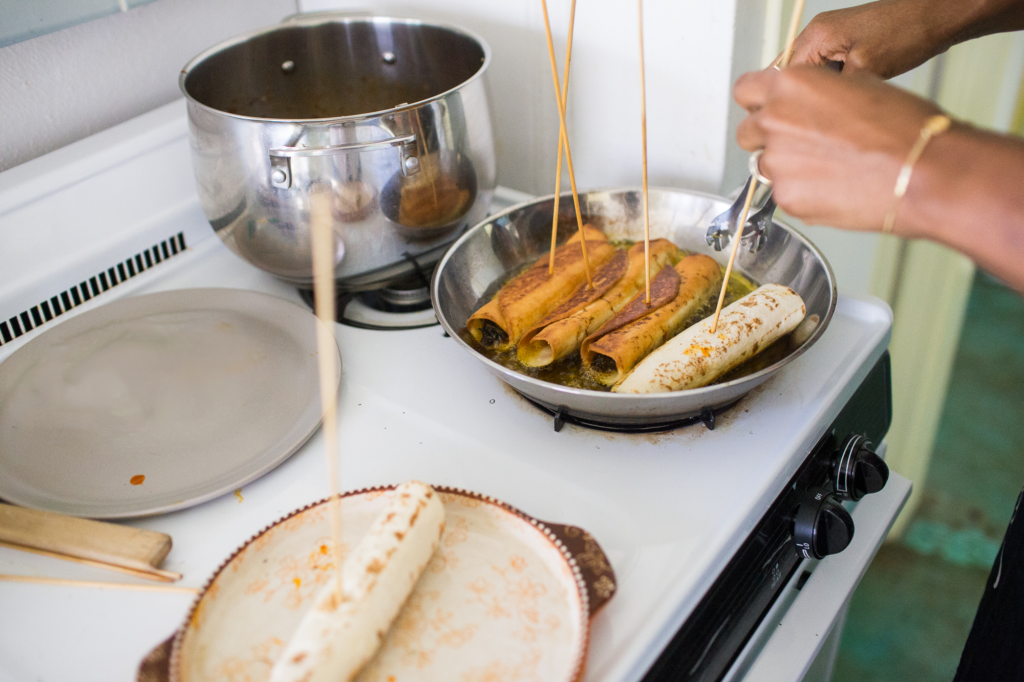
PHOTOS FROM THE FARM: 7.10.20
07/10/20 — Ada Broussard
Have you ever wondered what it would be like to work on a vegetable farm? Just about every other week our long-time farm photographer, Scott David Gordon, visits the fields and captures this experience. Scott has been visiting the farm regularly for many years now... almost 10! There are many familiar themes from year to year, and also many circumstances that make each season unique. And if we were ever to forget the nuances of a particular season, there are pictures to jog our memory. Last year at around this time, for example, our squash (both winter and summer), as well as melon crops, were suffering. We had heavy pest pressure of both the bug and hog variety. This year hogs have destroyed some of our melon crops, but overall, we're very happy with the volume and quality of all the cucurbits coming out of the field! As you can guess, this is also the first season where farmers' bandanas are being worn like bandits.
![]() Farmer Brenton's denim on denim farm look isn't complete without his cup of coffee, which is usually enjoyed from one of two vessels: a glass mason jar (pictured here) or the largest to-go cup the nearby Racetrac has to offer. Photo by Scott David Gordon.
Farmer Brenton's denim on denim farm look isn't complete without his cup of coffee, which is usually enjoyed from one of two vessels: a glass mason jar (pictured here) or the largest to-go cup the nearby Racetrac has to offer. Photo by Scott David Gordon.
![]() A socially distanced farm meeting is easily accomplished when you work outdoors. Photo by Scott David Gordon.
A socially distanced farm meeting is easily accomplished when you work outdoors. Photo by Scott David Gordon.
![]() Quality control. Photo by Scott David Gordon.
Quality control. Photo by Scott David Gordon.
![]() We love these personal sized watermelons - perfect for a CSA share. Photo by Scott David Gordon.
We love these personal sized watermelons - perfect for a CSA share. Photo by Scott David Gordon.
![]() When we're hiring at the farm, most job descriptions read "must be able to lift 50 lbs. repeatedly". Work one melon season, and you'll understand why that line exists. Photo by Scott David Gordon.
When we're hiring at the farm, most job descriptions read "must be able to lift 50 lbs. repeatedly". Work one melon season, and you'll understand why that line exists. Photo by Scott David Gordon.
![]() How to pick a good watermelon? The yellow spot often present on one side of a watermelon is called the "field spot", and this is the part of the melon that rests on the ground while it's developing. The darker and more yellow in color the field spot, the more time the melon spent ripening on the vine. A whitish field spot often means that the melon was harvested prematurely! Just look at these lovely yellow field spots. Photo by Scott David Gordon.
How to pick a good watermelon? The yellow spot often present on one side of a watermelon is called the "field spot", and this is the part of the melon that rests on the ground while it's developing. The darker and more yellow in color the field spot, the more time the melon spent ripening on the vine. A whitish field spot often means that the melon was harvested prematurely! Just look at these lovely yellow field spots. Photo by Scott David Gordon.
![]() Many home gardeners grow cucumbers up a trellis. At our scale, however, cukes are all grown on the ground and are harvested every single day. Photo by Scott David Gordon.
Many home gardeners grow cucumbers up a trellis. At our scale, however, cukes are all grown on the ground and are harvested every single day. Photo by Scott David Gordon.
![]() Did you know that squash leaves and stems are edible and are commonly eaten in many global cuisines? We don't harvest squash leaves here at JBG, but we're told that our friends at New Leaf Agriculture do. Photo by Scott David Gordon.
Did you know that squash leaves and stems are edible and are commonly eaten in many global cuisines? We don't harvest squash leaves here at JBG, but we're told that our friends at New Leaf Agriculture do. Photo by Scott David Gordon.
![]() Large harvests of our "winter" squash are rolling in. Butternut, for all! Photo by Scott David Gordon.
Large harvests of our "winter" squash are rolling in. Butternut, for all! Photo by Scott David Gordon.
![]() A train of just-harvested butternut squash, ready to be transferred to the coolers. Photo by Scott David Gordon.
A train of just-harvested butternut squash, ready to be transferred to the coolers. Photo by Scott David Gordon.
![]() The building, washing, and sanitizing IFCOs is one of the less-glamorous parts of working at our Pack Shed. The pile of IFCOs to-be-washed never truly ends. Photo by Scott David Gordon.
The building, washing, and sanitizing IFCOs is one of the less-glamorous parts of working at our Pack Shed. The pile of IFCOs to-be-washed never truly ends. Photo by Scott David Gordon.
 Farmer Brenton's denim on denim farm look isn't complete without his cup of coffee, which is usually enjoyed from one of two vessels: a glass mason jar (pictured here) or the largest to-go cup the nearby Racetrac has to offer. Photo by Scott David Gordon.
Farmer Brenton's denim on denim farm look isn't complete without his cup of coffee, which is usually enjoyed from one of two vessels: a glass mason jar (pictured here) or the largest to-go cup the nearby Racetrac has to offer. Photo by Scott David Gordon.
 A socially distanced farm meeting is easily accomplished when you work outdoors. Photo by Scott David Gordon.
A socially distanced farm meeting is easily accomplished when you work outdoors. Photo by Scott David Gordon.
 Quality control. Photo by Scott David Gordon.
Quality control. Photo by Scott David Gordon.
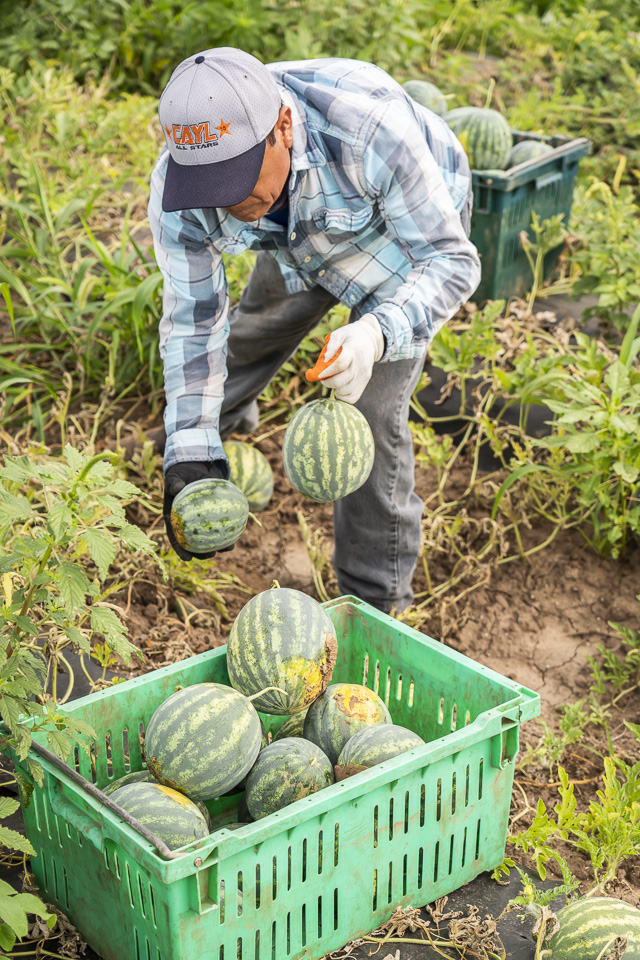 We love these personal sized watermelons - perfect for a CSA share. Photo by Scott David Gordon.
We love these personal sized watermelons - perfect for a CSA share. Photo by Scott David Gordon.
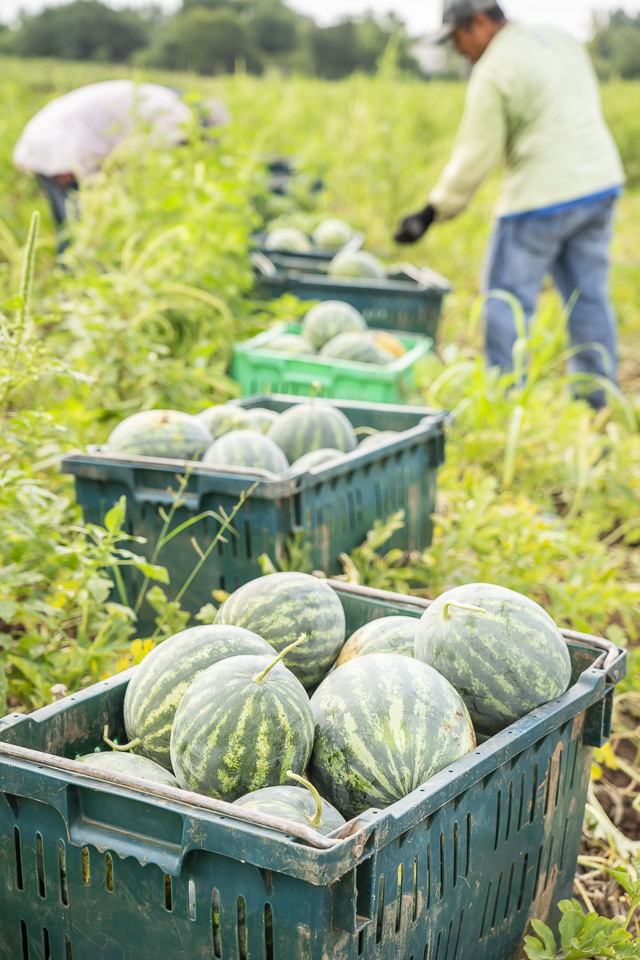 When we're hiring at the farm, most job descriptions read "must be able to lift 50 lbs. repeatedly". Work one melon season, and you'll understand why that line exists. Photo by Scott David Gordon.
When we're hiring at the farm, most job descriptions read "must be able to lift 50 lbs. repeatedly". Work one melon season, and you'll understand why that line exists. Photo by Scott David Gordon.
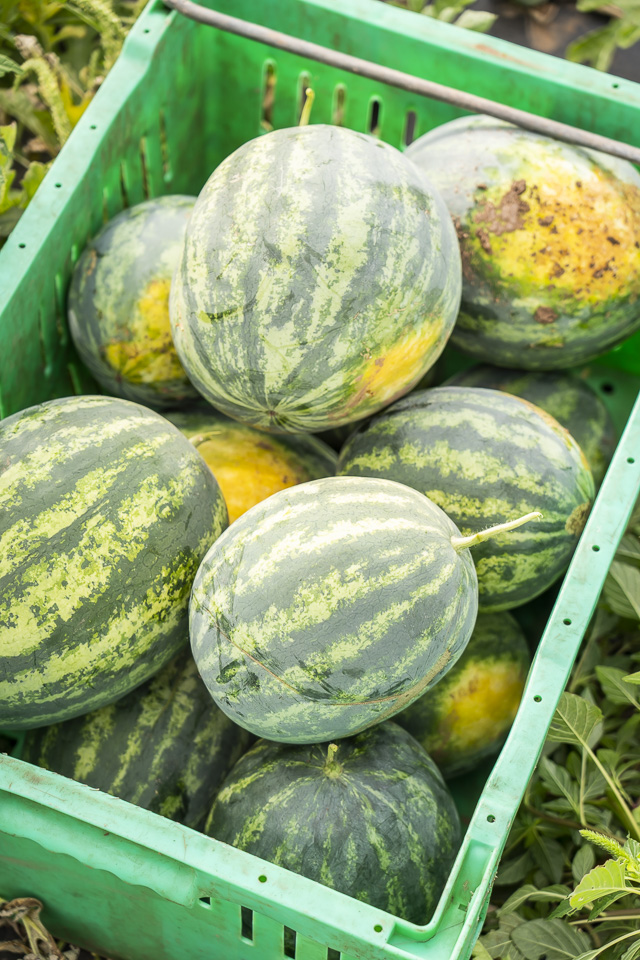 How to pick a good watermelon? The yellow spot often present on one side of a watermelon is called the "field spot", and this is the part of the melon that rests on the ground while it's developing. The darker and more yellow in color the field spot, the more time the melon spent ripening on the vine. A whitish field spot often means that the melon was harvested prematurely! Just look at these lovely yellow field spots. Photo by Scott David Gordon.
How to pick a good watermelon? The yellow spot often present on one side of a watermelon is called the "field spot", and this is the part of the melon that rests on the ground while it's developing. The darker and more yellow in color the field spot, the more time the melon spent ripening on the vine. A whitish field spot often means that the melon was harvested prematurely! Just look at these lovely yellow field spots. Photo by Scott David Gordon.
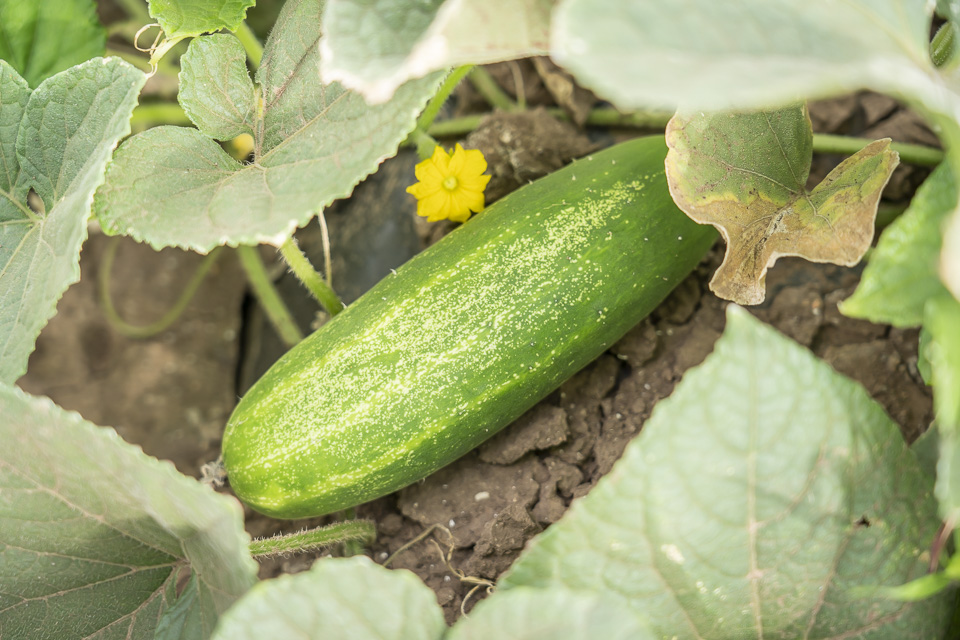 Many home gardeners grow cucumbers up a trellis. At our scale, however, cukes are all grown on the ground and are harvested every single day. Photo by Scott David Gordon.
Many home gardeners grow cucumbers up a trellis. At our scale, however, cukes are all grown on the ground and are harvested every single day. Photo by Scott David Gordon.
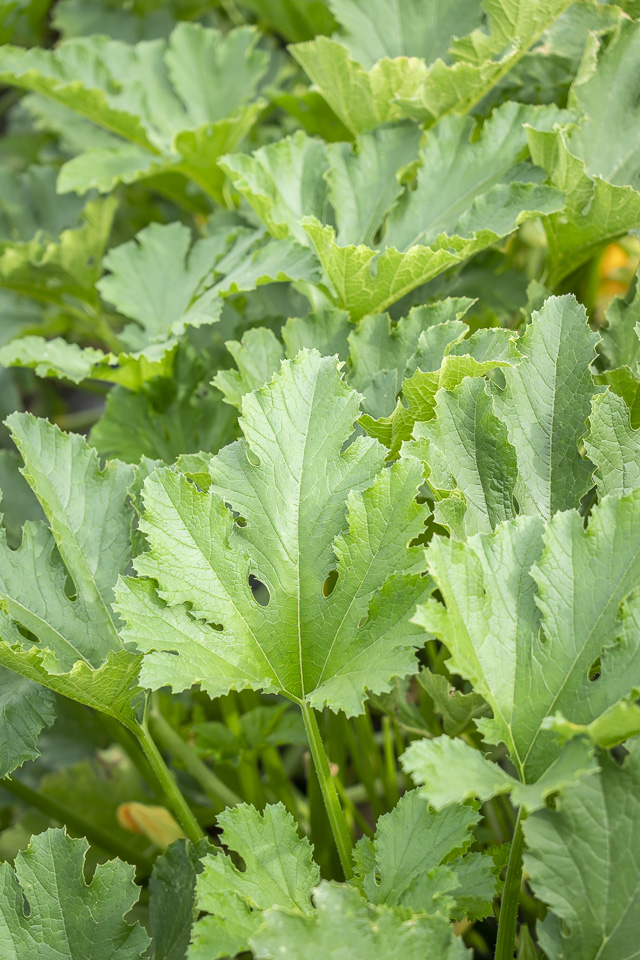 Did you know that squash leaves and stems are edible and are commonly eaten in many global cuisines? We don't harvest squash leaves here at JBG, but we're told that our friends at New Leaf Agriculture do. Photo by Scott David Gordon.
Did you know that squash leaves and stems are edible and are commonly eaten in many global cuisines? We don't harvest squash leaves here at JBG, but we're told that our friends at New Leaf Agriculture do. Photo by Scott David Gordon.
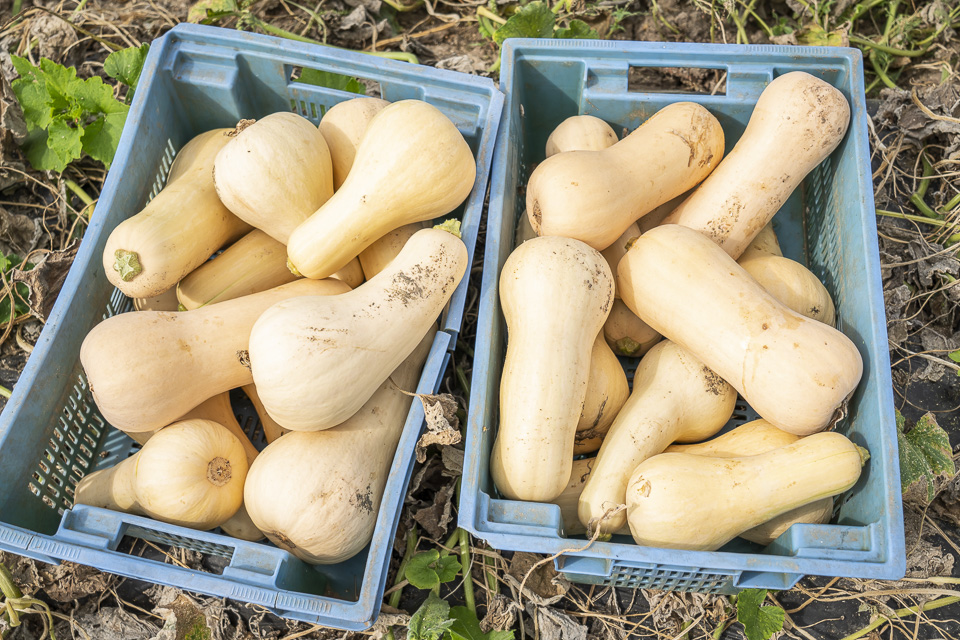 Large harvests of our "winter" squash are rolling in. Butternut, for all! Photo by Scott David Gordon.
Large harvests of our "winter" squash are rolling in. Butternut, for all! Photo by Scott David Gordon.
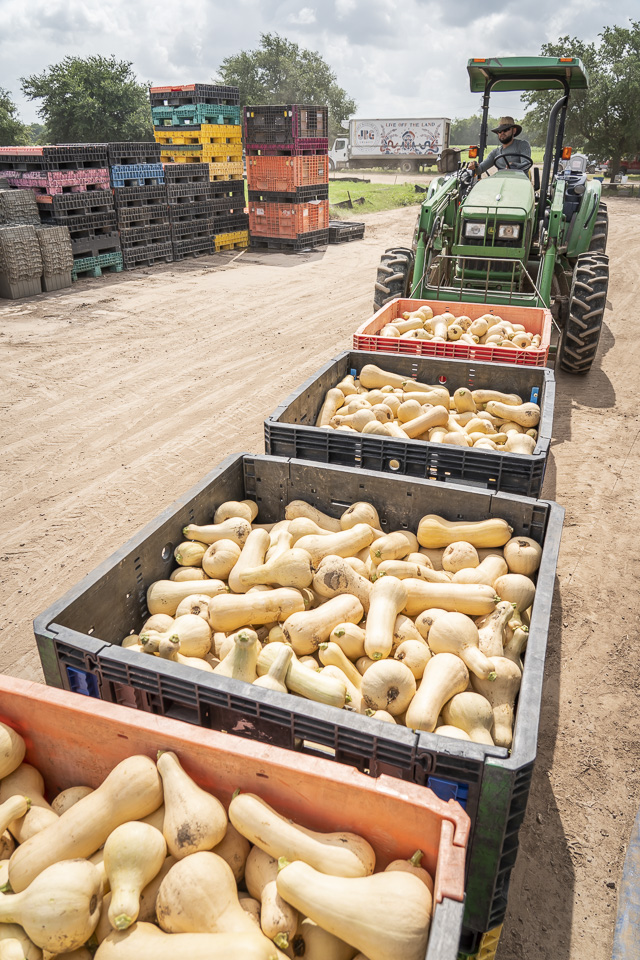 A train of just-harvested butternut squash, ready to be transferred to the coolers. Photo by Scott David Gordon.
A train of just-harvested butternut squash, ready to be transferred to the coolers. Photo by Scott David Gordon.
 The building, washing, and sanitizing IFCOs is one of the less-glamorous parts of working at our Pack Shed. The pile of IFCOs to-be-washed never truly ends. Photo by Scott David Gordon.
The building, washing, and sanitizing IFCOs is one of the less-glamorous parts of working at our Pack Shed. The pile of IFCOs to-be-washed never truly ends. Photo by Scott David Gordon.





 0 ITEMS IN CART
0 ITEMS IN CART 

